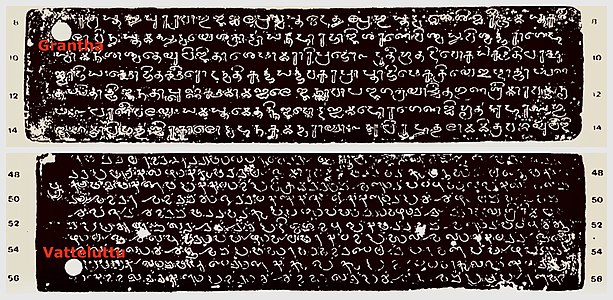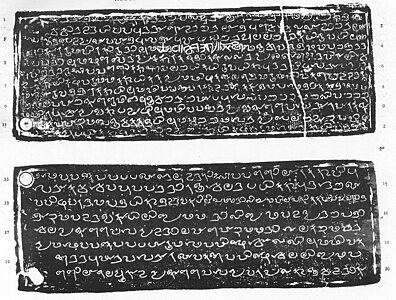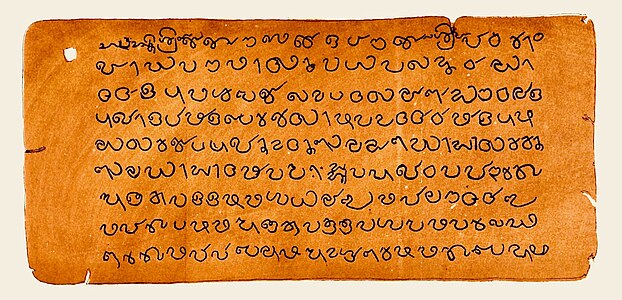Abugida used in southern Indian subcontinent (c. 6th–12th centuries)
| Vatteluttu | |
|---|---|
 Vatteluttu in modern Vatteluttu typeface Vatteluttu in modern Vatteluttu typeface | |
| Script type | Abugida |
| Direction | Left-to-right |
| Languages | Tamil, Malayalam |
| Related scripts | |
| Parent systems | Egyptian hieroglyphs |
| Child systems | Koleluttu (script) |
| Sister systems | |
| This article contains phonetic transcriptions in the International Phonetic Alphabet (IPA). For an introductory guide on IPA symbols, see Help:IPA. For the distinction between , / / and ⟨ ⟩, see IPA § Brackets and transcription delimiters. | |
| Brahmic scripts |
|---|
| The Brahmi script and its descendants |
| Northern Brahmic |
| Southern Brahmic |
Vatteluttu or Vattezhuthu (Tamil: வட்டெழுத்து, Vaṭṭeḻuttu and Malayalam: വട്ടെഴുത്ത്, Vaṭṭeḻuttŭ, IPA: [ʋɐʈːeɻut̪ːɨ̆]) was an alphasyllabic writing system of south India (Tamil Nadu and Kerala) and Sri Lanka used for writing the Tamil and Malayalam languages. This script is the sister of the Pallava script which was once in development in Southeast Asia.
Vatteluttu belonged to the group of Tamil-Malayalam scripts among the Southern Brahmi derivatives. The script was used for centuries in inscriptions and manuscripts of south India.
Etymology
Three possible suggestions for the etymology of the term 'Vatteluttu' are commonly proposed. Eḻuttu is literally 'written form' in this context; and affixed here it means 'writing system' or 'script'.
The three suggestions are:
- Vatte + eluttu; 'rounded script'
- Vata + eluttu; 'northern script'
- Vette + eluttu; 'chiseled script'
The script was also known as Tekken-Malayalam or Nana-mona. The name "Nana-mona" is given to it because, at the time when it is taught, the words "namostu" etc. are begun, which are spelt "nana, mona, ittanna, tuva" (that is, "na, mo and tu"), and the alphabet therefore came to be known as the "nana-mona" alphabet.
History
Vatteluttu probably started developing from Tamil-Brahmi from around the 4th or 5th century AD. The earliest forms of the script have been traced to memorial stone inscriptions from the 4th century AD. It is distinctly attested in a number of inscriptions in Tamil Nadu from the 6th century AD. By the 7th to 8th centuries, it had developed into a completely separate script from Tamil-Brahmi. Its use is also attested in north-eastern Sri Lankan rock inscriptions, such as those found near Trincomalee, dated to between c. the 5th and 8th centuries AD.
Vatteluttu was replaced by the Pallava-Grantha script from the 7th century AD in the Pallava court. From the 11th century AD onwards the Tamil script displaced the Pallava-Grantha as the principal script for writing Tamil. In what is now Kerala, Vatteluttu continued for a much longer period than in Tamil Nadu by incorporating characters from Pallava-Grantha to represent Sanskrit loan words in early Malayalam. Early Malayalam inscriptions (c. 9th and 12th century AD) are composed mostly in Vatteluttu. The script went on evolving in Kerala during this period and from c. the 12th century onwards.
Replacement
- Vatteluttu gradually developed into a script known as "Koleluttu" in Kerala. This script was more commonly used in north Kerala. It continued in use among certain Kerala communities, especially Muslims and Christians, even after the 16th century and up to the 19th century AD.
- Another script derived from Vatteluttu was the "Malayayma" or "Malayanma". This script was more commonly used in southern Kerala. The script is not, however, the one that is ancestral to the modern Malayalam script.
- The modern Malayalam script, a modified form of the Pallava-Grantha script, later replaced Vatteluttu for writing the Malayalam language.
Letters

The script continuously went on evolving during its period of existence (in such a way that the date of a record may be fixed approximately by reference to the script alone).
- Last quarter of the 8th century – the difference between two similar letters, such as for instance between 'p' and 'v'; and 'ṅ' and 'l' etc., was very markedly shown.
- A few centuries later – difficult to distinguish between 'k' and 'c', 'ṅ' and 'l', 'p' and 'v' and so on.
- 17th-18 centuries – letters 'p', 'v', 'y', and 'n' and sometimes 'l' also, are alike.
| Vatteluttu | ISO | Equivalent letter in | |
|---|---|---|---|
| Tamil | Malayalam | ||
| a | அ | അ | |
| ā | ஆ | ആ | |
| i | இ | ഇ | |
| u | உ | ഉ | |
| e | எ | എ | |
| Vatteluttu | ISO | Equivalent letter in | |
|---|---|---|---|
| Tamil | Malayalam | ||
| k | க | ക | |
| ṅ | ங | ങ | |
| c | ச | ച | |
| ñ | ஞ | ഞ | |
| ṭ | ட | ട | |
| ṇ | ண | ണ | |
| t | த | ത | |
| n | ந | ന | |
| p | ப | പ | |
| m | ம | മ | |
| Vatteluttu | ISO | Equivalent letter in | |
|---|---|---|---|
| Tamil | Malayalam | ||
| ṟ | ற | റ | |
| y | ய | യ | |
| r | ர | ര | |
| l | ல | ല | |
| ḷ | ள | ള | |
| v | வ | വ | |
-
 Velvikudi Grant (8th century AD, Tamil)
Velvikudi Grant (8th century AD, Tamil)
-
 Quilon Plates (9th century AD, Old Malayalam)
Quilon Plates (9th century AD, Old Malayalam)
-
 Jewish Plates (11th century AD, Old Malayalam)
Jewish Plates (11th century AD, Old Malayalam)
Unicode
Not yet added to unicode but proposals have been made to add it.
See also
References
- "Vatteluttu". Omniglot.com.
- ^ Rajan, K. (2001). "Territorial Division as Gleaned from Memorial Stones". East and West. 51 (3/4): 359–367. JSTOR 29757518.
- ^ Narayanan, M. G. S. (2013) . Perumāḷs of Kerala: Brahmin Oligarchy and Ritual Monarchy. Thrissur (Kerala): CosmoBooks. pp. 379-80 and 398. ISBN 9788188765072.
- ^ Coulmas, Florian (1999). The Blackwell Encyclopedia of Writing Systems. Blackwell Publishing. p. 542. ISBN 9780631214816.
- ^ Krishnamurti, Bhadriraju. "Tamil Language". Encyclopædia Britannica.
- ^ Krishnamurti, Bhadriraju (2003). The Dravidian Languages. Cambridge University Press. pp. 78, 84–85. ISBN 978-1-139-43533-8.
- ^ Freeman, Rich (2003). "The Literary Culture of Premodern Kerala". In Sheldon, Pollock (ed.). Literary Cultures in History. University of California Press. p. 481. ISBN 9780520228214.
- ^ Rao, T. A. Gopinatha. Specimens of Vatteluttu Inscriptions. Travancore Archaeological Series. Vol. XVI (1911 ed.). Government of Travancore. pp. 283–84.
- Mahadevan, Iravatham (2003). Early Tamil Epigraphy: From the Earliest Times to the Sixth Century AD. Harvard University Press. pp. 210–213. ISBN 978-0-674-01227-1.
- Salomon, Richard (2004). "Review: Early Tamil Epigraphy: From the Earliest Times to the Sixth Century AD". The Journal of the American Oriental Society. 124 (3). Harvard Oriental Series: 565–569. doi:10.2307/4132283. JSTOR 4132283.
- Manogaran, Chelvadurai (2000). The Untold Story of Ancient Tamils in Sri Lanka. Chennai: Kumaran Publishers. p. 31.
- Veluthat, Kesavan. "History and Historiography in Constituting a Region: The Case of Kerala." Studies in People’s History, vol. 5, no. 1, June 2018, pp. 13–31.
- "Roadmap to the SMP". Unicode Consortium. Retrieved 21 August 2023.
External links
| Tamil language | |||||||||||||
|---|---|---|---|---|---|---|---|---|---|---|---|---|---|
| History | |||||||||||||
| Dialects |
| ||||||||||||
| Global organizations | |||||||||||||
| Literature |
| ||||||||||||
| Tamil and other languages | |||||||||||||
| Scripts | |||||||||||||
| Lexis and grammar | |||||||||||||
| Phonology | |||||||||||||
| Transliteration | |||||||||||||
| Events | |||||||||||||
| Kawi family | |||||
|---|---|---|---|---|---|
| Scripts |
| ||||
| Origin/mother scripts | |||||




















